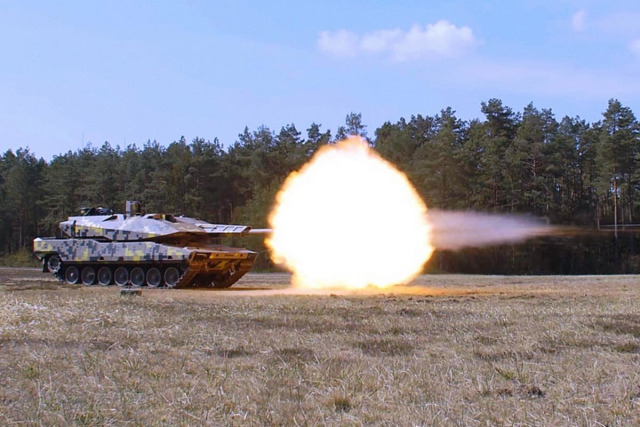We continue to publish additional materials about the new main battle tank (MBT) of the Rheinmetall concern "Panther" KF51. The first article of the series was an introduction to the topic. In this article we will talk about the tank's weapons systems. The speaker of the profile forum in Berlin is Dr. Tobias Schmidt, Program Director of Rheinmetall Future Gun System (FGS).
Improved firepower of the MBT "Panther" KF51
Opening his speech on the issue of the lethality of the Panther KF51, T. Schmidt said: "The firepower of the MBT has the right to exist, and, in our opinion, the main gun will remain the dominant effector for the tank."
It is obvious that the main targets for the MBT are enemy heavy armored vehicles and other combat vehicles, as well as calculations of anti-tank guided missiles (ATGM) and dismounted infantry. However, the tank can also be used to destroy infrastructure, while protecting itself from threats emanating from the third dimension, namely combat helicopters, and currently barrage ammunition (BB) and unmanned aerial vehicles (UAVs).
A large-caliber cannon is mainly intended to be used against enemy armored vehicles. At the same time, various types of ammunition are used, for example, kinetic (KE) and multi-purpose high-explosive fragmentation (MPHE), the latter are also used against helicopters and infrastructure facilities. Secondary weapons are mainly used against infantry at a closer distance or against drones. "A tank MHPE can generate more shrapnel than a 35mm shell burst," adds T. Schmidt.
Learn more about the 130 mm main gun
The Panther KF51 is equipped with a 130 mm main gun developed by Rheinmetall since 2015. In addition to the information already published in Berlin, it was additionally reported that in order to defeat the enemy's MBT, which are the main task of the main gun, a long range is required (we were talking about a distance of more than 3,500 m), as well as high hit accuracy and efficiency in order to reliably neutralize the target until the end of the battle.
According to the figures presented, high efficiency means the ability to hit the equivalent of homogeneous armor with a thickness of more than 1000 mm, protection, of course, is currently provided by a combination of passive, reactive and active armor. T. Schmidt spoke out for the superiority of the tank gun in duels with the MBT, because he believes that the gap in protection from diving and attacking from above means, such as ATGM and remote-controlled ammunition, will soon be closed by new forms of active protection systems. Therefore, kinetic energy remains the best way to neutralize enemy tanks.
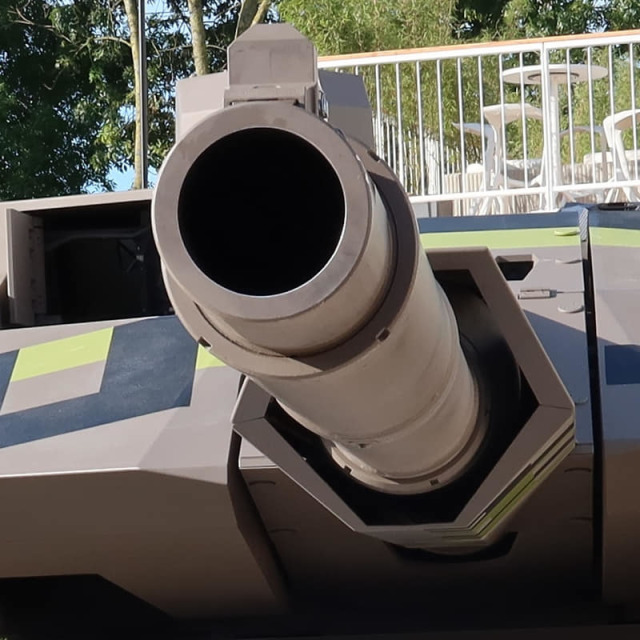
130 mm gun "Panther" KF51Justifying the increase in caliber from 120 to 130 mm, the expert referred to the results of a study conducted in the mid-2010s by Rheinmetall concern.
They showed that the combination of the L55A1 cannon with the DM73 APFSDS [armor-piercing sub-caliber] ammunition provides sufficient striking capability against modern enemy targets at a range of 1000 m, and the new DM83 adds another 500 m. It is expected that this munition will enter service in 2024. However, this was considered to exhaust the growth potential of the 120 mm smoothbore cannon developed in the 1970s, and meant that it was impossible to increase the firing range and increase efficiency against new and more protected targets. Hence the decision to increase the caliber to meet the new requirements defined by customers.
At the same time, a much higher degree of automation was required. On the one hand, the number of systems installed in the tower is constantly increasing, so automated functions can reduce the load on the crew. This will also be a key factor in the future, as Rheinmetall foresees the emergence of large-caliber unmanned turrets that will also be installed on unmanned platforms. In addition to adding automation functions, an automatic loading device is mandatory due to the weight of the ammunition.
The Rheinmetall development team sought to increase the maximum firing range of 1.5 km of a smaller caliber gun by 1000 or even 2000 m. All this was planned to be done in a weapon system that can be installed on a platform with a maximum combat weight of 40-50 tons. Thus, the company seeks to stop the spiral of weight gain, which has brought the current MBT to the 80-ton mark.
Being a new system, the 130 mm cannon is designed with the inherent growth potential in mind to cope with increased protection from the enemy. "We aim to achieve TRL6 [testing of a model or prototype in real conditions] in 2026. In the first four years, starting in 2015, we carried out a lot of optimization in order to find a suitable ammunition for this future weapon system, and in parallel we carried out conceptual work on automatic loading and research of weapon components," T. Schmidt explained.
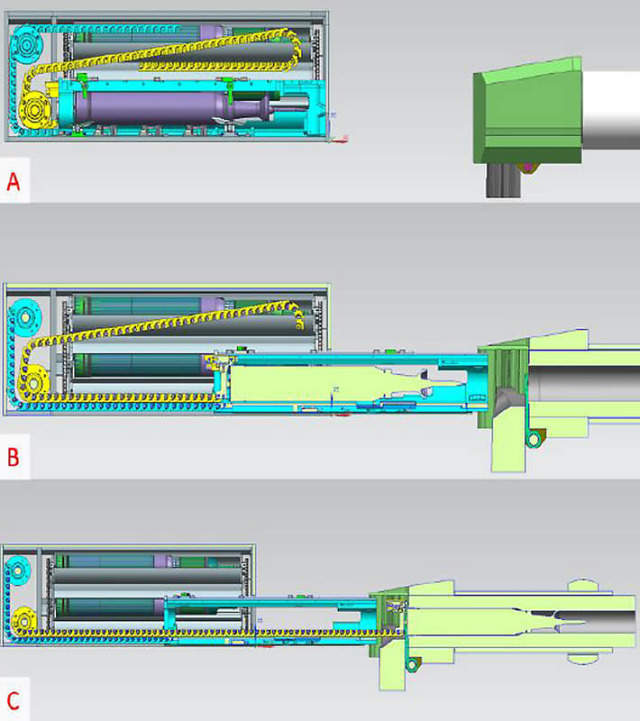
The scheme of operation of the automatic loaderBefore moving on to the current weapon, Rheinmetall considered various calibers and breech volumes, from 120 to 157 mm and from 10 to 20 liters, as well as extreme operating pressure from 700 to 800 MPa.
The maximum length of the trunk was set at 8 m . The interfaces between weapons, ammunition, target, turret and loader were considered. The internal ballistics was optimized for a much larger camera than that of a 120 mm cannon.
Since 2016, three different types of ammunition prototypes have been developed and released for testing, while a number of other parameters have been analyzed, including recoil force, muzzle energy, barrel and weapon mass, and others. The next four years were spent on the development of subsystems, such as different versions of the barrel, recoil system, cradle and automatic loader, their integration into the tower. Then tests began at the subsystem and system level. "We conducted the first firing tests of the weapon in the turret, although not fully integrated, and then conducted additional tests of accuracy and performance, hitting the target at a distance of 1000 m with four shots," said T. Schmidt.
The automatic loader is one of the key components. Developed by Rheinmetall Air Defense in Oerlikon, near Zurich, it is integrated into the tower, which allows you to check the entire loading sequence. The loading time standards require less than 3 seconds and the feed time less than 2 seconds, the breech takes about 1 second to move backwards and another second to move forward. Charging is controlled by a number of sensors, and since the system is completely new, additional time is allocated, 3-4 seconds, for safety checks. "Since the muzzle energy is about 18 MJ, we want to make sure before firing that everything is correct," T. Schmidt stressed.
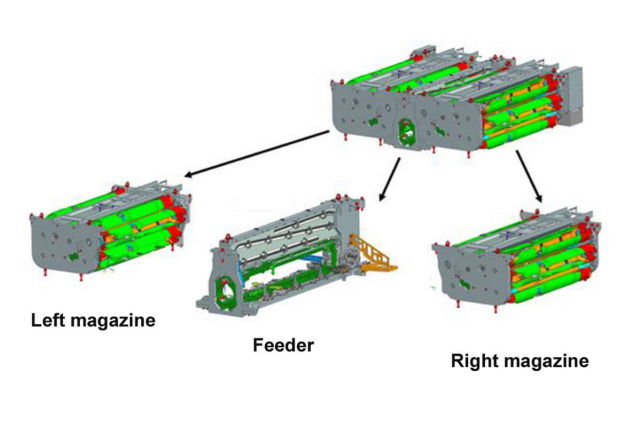
Layout of magazines and automatic loaderThe speaker also confirmed the already available data on 20 shots, divided into two magazines, on both sides of the loading mechanism, adding, however, that the number of shots can be increased to 30, "but at the same time a lot of space is lost around."
According to the speaker, since a quick reloading procedure is available, this is enough for 20 shots.
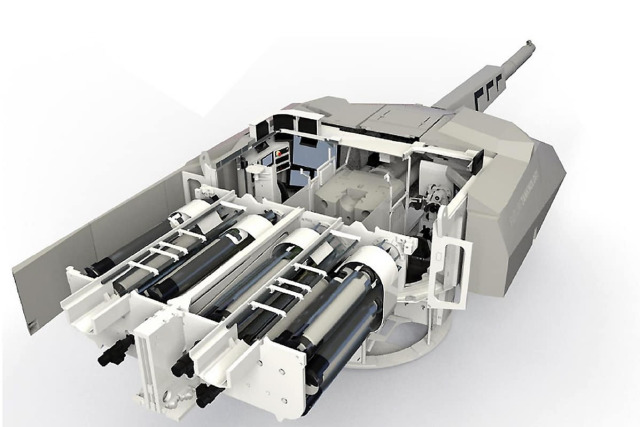
Placement of shops and automatic loader in the towerAutomatic loading provides not only loading of ammunition, but also unloading, which is a feature compared to other systems that cannot perform unloading.
"This is because we are considering the possibility of using it in an unmanned turret, so it should be able to perform all operations," he added, explaining that the time required for discharging is about 6 seconds, since pulling out the projectile should be performed with less effort compared to loading. This means that unloading one ammunition and firing the next one will take about 9 seconds. In addition, the KF51 Panther automatic loader is also capable of redistributing ammunition in stores. This allows, for example, to fill one of the stores, emptying the other to replace it.
Secondary weapons are the key to defeating secondary targets
As already mentioned, Rheinmetall offers its "Panther" KF51 with 20 rounds of ammunition, so secondary weapons are key for hitting secondary targets. The reduced number of shells available for a 130 mm cannon compared to tanks armed with 120 mm cannons (the Leopard 2 carries 42 rounds) led to the choice of a 12.7mm heavy machine gun as a paired weapon capable of hitting lightly armored and light targets at medium ranges. "It [the machine gun] is equipped with some automated functions, for example, elimination of a misfire," T. Schmidt noted.
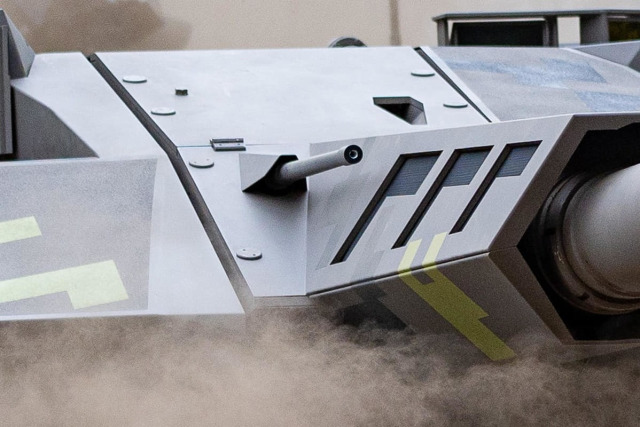
The course machine gun "Panther" KF51The machine gun is controlled using a universal interface that makes it independent of the gun.
The power is supplied from a box with 1250 cartridges. In addition, a remotely controlled Natter weapon station is located at the rear of the tower. It can also be equipped with a 12.7mm machine gun, but also a lighter 7.62mm machine gun or a 40 mm automatic grenade launcher, and provides full coverage of the hemisphere. The elevation angle of the station is from -15° to +85°.
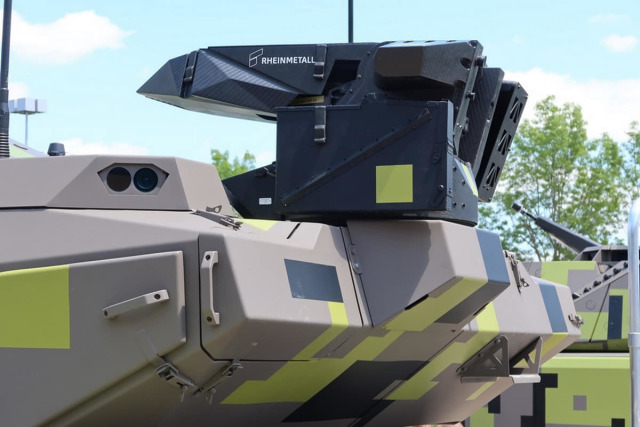
Natter Weapons StationWith a weight of about 100 kg, the station is equipped with its own sighting system and can be used by every crew member.
Armed with a 7.62 mm machine gun, Natter has proven its effectiveness against slow-moving UAVs at a range of up to 300 m, using automatic tracking and a grid firing mode that provides sufficient dispersion to hit the target. Ammunition 2500 rounds. To ensure the proper capabilities of the counter-UAV (C-UAS), the installation of a high-quality drone detection and recognition system is required.
High-speed 40 mm pneumatic grenades are also quite effective against UAVs at a distance of up to 600-800 m, especially if hard-hitting effectors are connected to soft-hitting systems, such as electronic warfare effectors. They jam drones, reducing their maneuverability, which is extremely necessary, given the relatively low rate of fire. The muzzle velocity of a 40 mm grenade is about 240 m/s. To do this, the programmable end of the 40 mm cartridge should not be subject to jamming, so the grenades are equipped with a special programming system. According to Rheinmetall estimates, a UAV can be hit by a burst of 6-8 grenades, and an ammunition box allows you to perform 3-4 bursts.
Despite the fact that the Panther KF51 is not yet integrated, it can be equipped with a high-energy laser weapon station, the beam of which is fed through the commander's optoelectronic sight. According to T. Schmidt, the energy storage can be installed in the rear of the tank, due to the fact that the engine and gearbox have reduced dimensions compared to the original Leopard 2. The data provided indicates an output power of 4 to 10 kW with a response time of 4-5 seconds. At the same time, 4-5 triggers make up a realistic option before the need to recharge the energy source. The main task of such an additional system, of course, will be to counteract the approaching UAVs and BB.
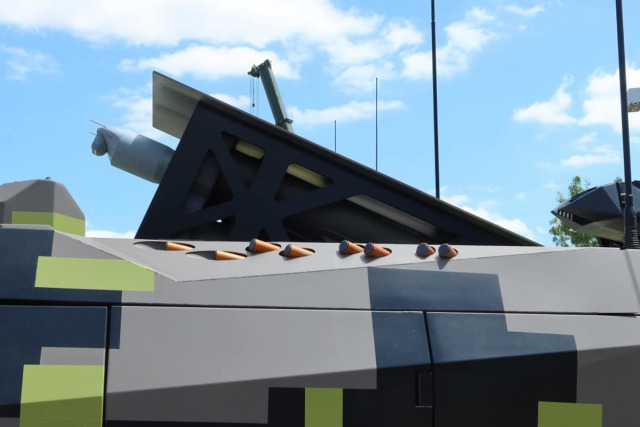
The launcher of the Hero 120 barrage ammunitionAs already emphasized in the publications, one of the stores of the automatic loading device can be replaced with a container containing, for example, four uVision Hero 120 BB with a flight range of 40 km, equipped with anti-tank or multi-purpose warheads.
Controlling the BB will definitely be the task of the fourth crew member.
System status
At various stages of development since 2016, Rheinmetall has fired more than 300 rounds from its 130 mm gun, reaching a muzzle velocity of 1,700 to 1,900 m/s, which means approximately 18 MJ of muzzle energy, which is 50% more than that of a 120 mm gun. "As a growth potential, we have new technologies that we have not yet implemented.The current ammunition is close to DM63 or DM73.This is a reliable technology that we have used to test weapons, but we plan to introduce new ammunition technology at a later stage to further improve performance," said Dr. T. Schmidt.
Additionally, it was reported that after the presentation at Eurosatory in June 2022, the Panther KF51 passed numerous tests. Among them, a full cycle of loading on the move in increasingly difficult conditions, such as a slope of 60% or a lateral slope of 30 °, while shooting on the move has not yet been performed. Nevertheless, static firing took place, testing the entire chain up to operational firing. This stage will be completed in March 2023, when a further testing phase will begin, which will include all electronics.
To be continued…
By resource material edrmagazine.eu
